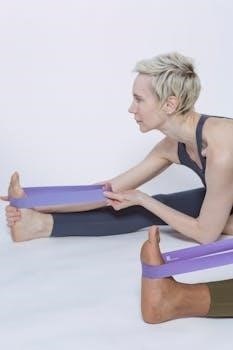The Iliotibial (IT) band is crucial for knee stabilization, running along the thigh from the pelvis to the shinbone. IT band syndrome, often due to overuse, can cause pain and discomfort. Stretching surrounding muscles, not the IT band itself, improves flexibility and movement.
What is IT Band Syndrome?
IT Band Syndrome, or Iliotibial Band Syndrome, is a common condition characterized by pain on the outside of the knee, and sometimes the hip. It’s not actually a problem with the band itself, but rather the result of inflammation and irritation of the tissues surrounding the IT band. This thick band of tissue runs from the hip down the outside of the thigh to the shinbone, playing a vital role in stabilizing the knee. Overuse, repetitive motions, or biomechanical issues can lead to tightness and friction of the IT band. When this occurs, the band rubs against the bony prominence of the femur, causing pain. Activities such as running, cycling, and hiking, particularly when done with improper form, can contribute to the development of IT band syndrome. Weakness in the hip muscles, especially the glutes, can also contribute by allowing for increased stress on the IT band. Identifying and addressing the underlying causes is crucial for effective management of this condition.
Importance of Stretching for IT Band Syndrome
While the IT band itself is not a muscle and cannot be stretched in the traditional sense, stretching the muscles surrounding it is crucial for managing and preventing IT Band Syndrome. These stretches help to reduce tension, improve flexibility, and restore range of motion in the hip and leg, thus relieving pressure on the IT band. Regular stretching of the hip flexors, glutes, quadriceps, and hamstrings can alleviate the tightness that often contributes to IT band irritation. By increasing the flexibility of these surrounding muscles, you can decrease friction on the IT band and reduce the pain and discomfort associated with the syndrome. Furthermore, stretching can improve blood flow to the area, aiding in healing and reducing inflammation. Incorporating a consistent stretching routine into your daily life can help you manage your symptoms and avoid flare-ups. Stretching is a crucial element in a comprehensive plan to combat IT Band Syndrome.

Effective IT Band Stretches
Several effective stretches can target the muscles that influence the IT band, such as the standing, side-leaning, and wall supported stretches. These aim to improve flexibility and reduce pain and tension.
Standing IT Band Stretch
To perform the standing IT band stretch, begin by positioning yourself sideways to a wall, ensuring the leg you wish to stretch is closest to the wall, about an arm’s length away for support. Cross the leg that you intend to stretch behind your other leg; Next, slowly lean your hip toward the wall. As you lean, you should feel a stretch along the outside of your hip and leg. Maintain this position for approximately 20 seconds, and then repeat this stretching action for 3 to 5 times. It is recommended to perform this stretch once each day. You can use a chair or counter for support if needed. Remember to keep your back straight and focus on the stretch in your hip and outer thigh. This stretch targets the muscles connected to the IT band, helping to relieve tension and improve flexibility over time.
Side-Leaning IT Band Stretch
To execute the side-leaning IT band stretch, position yourself sideways to a wall with the leg that is affected by IT band syndrome positioned closest to the wall. If you find it difficult to maintain balance, feel free to use a chair or counter for added stability. Stand on the leg that is affected, ensuring it is close to the wall. Then, cross your other leg in front of it. Allow your affected hip to drop out to the side of your body, leaning against the wall. You should feel a stretch along the outside of your hip and thigh. Hold this position for about 20 to 30 seconds. Repeat this stretch several times daily, gradually increasing repetitions as you become more comfortable. This stretch is effective for targeting the IT band and the muscles surrounding it, helping to improve flexibility and reduce tightness. Remember to listen to your body and avoid pushing through any sharp pain.
IT Band Stretch with Wall Support
For the IT band stretch with wall support, begin by standing sideways to a wall, positioning the leg you intend to stretch closest to the wall, and about an arm’s length away for support. Cross the leg that you will be stretching behind your other leg. Slowly lean your hip towards the wall until you start to feel a gentle stretch along the outer part of your hip and leg. It is important to maintain a controlled movement, avoiding any sudden or jerky motions. Hold this position for approximately 20 seconds, and then repeat the stretch three to five times. This exercise should be done once daily. This method helps to effectively target the IT band and surrounding muscles, promoting flexibility and reducing discomfort; Remember, consistency is key to achieving the best results with this stretch.
Iliotibial Band Stretch (Side-Bending)

For the iliotibial band stretch using side-bending, stand with the leg you want to stretch closest to a wall. If balance is a concern, feel free to use a chair or counter for support. Position the leg that is affected near the wall, then cross the opposite leg in front; Allow your affected hip to gently drop out to the side of your body, leaning against the wall. You should feel a stretch along the outside of your hip and thigh. The goal is to lean away from the hip and the IT band that is being stretched. You can place your hand on the opposite side overhead, and the other hand on your waist. Hold the position for a duration of 20 seconds and repeat this movement three to five times daily to help improve the flexibility of the IT band.
Supine ITB Stretch with Strap
To perform the supine ITB stretch with a strap, begin by lying on your back with your legs extended. Take a strap, towel, or belt and loop it around the foot of the leg you wish to stretch. Gently pull the strap, bringing the leg up towards the ceiling. Next, move the leg across your body towards the opposite shoulder. As you move the leg, you should feel a stretch along the outside of your thigh and hip. Hold the stretched position for 20 seconds. It’s crucial to maintain a straight leg throughout the stretch. Repeat this movement three to five times daily, gradually increasing the repetitions as your flexibility improves. This stretch helps improve the mobility of the IT band and surrounding muscles.

Supporting Stretches and Exercises
To support IT band flexibility, incorporate calf stretches, hamstring stretches, and piriformis muscle stretches. Hip strengthening exercises also play a vital role in stability and overall recovery.
Calf Stretches
Calf stretches are essential for supporting overall leg flexibility, which indirectly aids in managing IT band issues. These stretches help to release tension in the lower leg muscles, improving range of motion. A simple standing calf stretch involves placing one foot slightly behind the other, then leaning forward, bending the front knee. You should feel a stretch in the calf of the back leg. For a deeper stretch, try leaning against a wall. These stretches can be used during warm-ups to improve flexibility. The standing variation allows for easy access and can be performed anywhere. A variation of this stretch can also target the IT band. It’s important to hold each stretch for about 20-30 seconds and repeat multiple times. Regularly performing calf stretches is a simple and effective method for improving lower leg flexibility, aiding in IT band syndrome management by reducing muscle imbalances and tension.
Hamstring Stretches
Hamstring stretches play a vital role in managing IT band syndrome, as tight hamstrings can contribute to imbalances and increased strain on the IT band. Effective stretches include the supine hamstring stretch, where you lie on your back and use a strap or towel to gently pull your leg towards you, keeping your knee straight. Another option is the standing hamstring stretch, where you bend at the waist, reaching towards your toes. Focus on keeping your back straight and avoiding any sudden movements. The stretch should be felt along the back of the thigh. Using a wall can also aid in deeper stretches. Regular hamstring stretches help improve flexibility and range of motion in the posterior leg, thereby reducing stress on the IT band. It is very important to hold each stretch for 20-30 seconds and repeat them multiple times. These stretches can be incorporated into both pre and post workout routines.
Piriformis Muscle Stretch
The piriformis muscle, located deep in the hip, can significantly impact IT band issues when tight. A common method for stretching it involves the figure-four stretch. Begin by lying on your back and crossing one ankle over the opposite knee. Gently pull the uncrossed thigh towards your chest, feeling a stretch in the hip of the crossed leg. Another effective technique is the seated piriformis stretch, where you sit with one leg bent and the other crossed over it, then gently twist your torso toward the bent leg. Hold these stretches for around 20-30 seconds, repeating several times. Regular piriformis stretches alleviate tension in the hip area, which can decrease stress on the IT band. This approach will help with mobility and contribute to a well-rounded stretching routine for IT band syndrome management. It is important to perform these exercises slowly and carefully.
Hip Strengthening Exercises
Strengthening the hip muscles is crucial for stabilizing the pelvis and reducing strain on the IT band. Weak hip muscles often contribute to IT band issues. Side-lying leg lifts are effective; lie on your side and lift the top leg, keeping it straight. Clamshell exercises, done by lying on your side with knees bent and opening your knees while keeping feet together, target the outer hip muscles. Another essential exercise is the wall squat, performed by standing with your back against the wall, sliding down into a squat position, and then pushing back up. These are just a few examples of exercises to strengthen the hip. These strengthening exercises should be done with proper form and should be done regularly to ensure proper muscle strength. Focusing on hip strength improves overall lower body alignment and supports a full range of motion, which can lessen the symptoms of IT band syndrome.

Additional Resources
For further guidance, a PDF guide is available with detailed instructions and illustrations for various stretches and exercises. This resource can be downloaded for easy access and reference.
PDF Guides for IT Band Stretches
Downloadable PDF guides offer comprehensive instructions and illustrations for various IT band stretches and strengthening exercises. These resources provide a structured approach to managing IT band syndrome, including stretches for the iliotibial band itself, as well as supporting muscles like the calves and hamstrings. The guides often include detailed explanations of each exercise, along with images to ensure proper form and technique. They may also cover exercises like wall squats, side-lying leg lifts, and clam exercises, which help strengthen the surrounding musculature. These PDF files serve as a valuable tool for individuals seeking to alleviate pain, improve mobility, and prevent future issues. They frequently contain tips and advice on frequency and duration for each stretch. You can usually find these guides online on reputable websites. The detailed instructions will help you understand the exercises and perform them correctly.



